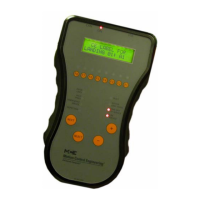The Computer
5-30 Manual # 42-02-1P21
Table 5.6 Spare Inputs Menu Options
Spare Inputs Menu Options
2AB Monitoring input for the 2AB relay coil - If the 2AB relay is ON, the R2AB input will be
OFF. R2AB should always be the opposite of 2AB otherwise, the 2AB redundancy fault is
logged and the elevator shuts down.
ABI Alarm Bell Input - This input monitors the car through remote monitoring software.
There are three conditions that will display a warning on the screen. First, if the Alarm
Button is pressed when the car is stopped outside of the door zone. Next, if the Alarm
Button is pressed four times in 60 seconds without the car moving. And lastly, if the car
fails to complete an LSA movement check after being idle for 10 minutes at a landing. All
of these failures will alert the monitoring station.
ACI Reserved for future use.
ALI Alternate Lobby Input - The ALI input is used to substitute the Main Lobby floor value
with an Alternate Lobby floor value. When the ALI input is activated, the lobby value is
taken not from the LOBBY parameter, but from the ALTLBY parameter. The ALTLBY floor
must be specified before using the ALI input.
ALV Alive Input - This input is used in a duplex configuration and is received from the other
car. If the input is on for this car, it states that the other car is powered. This input is
used in emergency power applications.
API Alternate Parking Input - This input is used to determine whether to park at the primary
parking floor, or at the alternate parking floor. When API is low, the car will park at the
primary floor. When API is high, the car will park at the alternate floor.
ARST Alarm Reset input - When the ARST input is activated, the alarm outputs DISL and DISB
are reset.
ATS Attendant Service Input - When the ATS input is activated, the car is under the control of
the attendant (starting, stopping, direction of travel). Doors open automatically when
the car is stopped at a landing. Doors are closed only through constant pressure on the
door close button, car call button, or either car direction button (UPI and DNI). The
attendant may cause the car to bypass all hall calls by activating the “non-stop button”
(NSI). The ATSOPT option must also be enabled. While the car is on Attendant Service,
all of the Load Weigher Functions (LLW, HLW, OLW) are cleared.
AUTO Emergency Power Auto Selection Input - This input is for duplexes only. When activated,
one of the cars will be automatically chosen to run “normally” on emergency power. The
dispatcher makes this decision, and will choose itself if able to run. The slave will be cho-
sen if the dispatcher is unavailable to run. See also the ALV input.
AXR Auxiliary Reset Input - Usually connected to a push button on a controller to reset redun-
dancy error conditions.
BAB Monitoring input for the BAB relay coil. If the BAB relay is ON, the RBAB input will be
OFF. RBAB should always be the opposite of BAB otherwise, the BAB redundancy fault is
logged and the elevator shuts down.
BSI Building Security Input - This input is used to activate MCE Security when the BSI SECU-
RITY KEY, in the Extra Features Menu (see “BSI SECURITY KEY” on page 5-50), is set to
ENABLED.
CCC Car Calls Cancel Input - Activation of this input will unconditionally cancel car calls.
Because this input has no logical qualification in the software, it is highly suggested that
necessary qualification be done in external circuitry (e.g., disable the signal feeding this
input when on Fire Service Phase II).
CEPFG When active, enables passing floor gong on CE fixture. Non-latching as opposed to PFGE
which latches until direction reversal.
CEVA When active, enables floor announcements on CE fixture. Always active if CEVA is not
programmed. When CEVA is not active, floor announcement on CE fixture is disabled.

